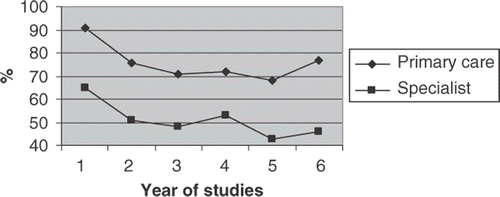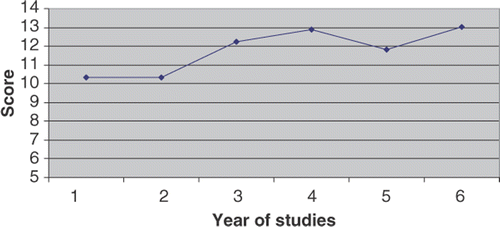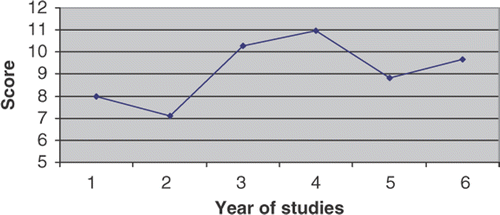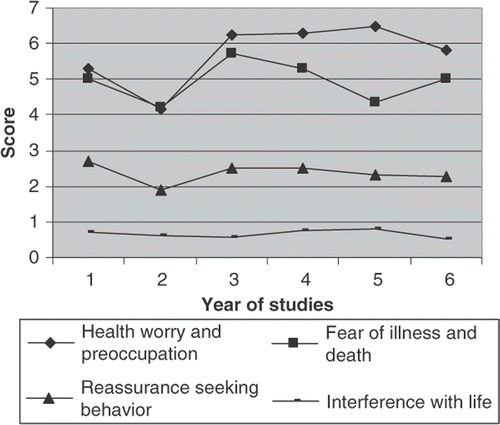Abstract
Background: Studying a specific illness could lead medical students to an incorrect interpretation of certain physical symptoms, so that symptoms which were previously considered normal are now regarded as a true sign of an illness.
Aim: To examine the appraisal of self-health state, the existing fear of morbidity and the level of health-related anxiety among medical students throughout medical school.
Methods: Anonymous questionnaires were distributed to first through sixth year medical students at the Tel-Aviv University Medical School. The questionnaires were distributed to all the students who were present on the study days.
Results: We observed a significant rise in the emotional–distress process with entering the clinical years followed by a significant decrease later on. Similar pattern was seen in health anxiety and in preoccupation with and fear of illness and death. While the perceptual–cognitive process increased gradually, there was no change in interference with life scores.
Conclusion: “Medical student's disease” should be regarded as a phenomenon depending on the years of learning. By breaking it down into its components, one can better characterize it and predict its onset. By defining it as a normal process, one can assist in guiding medical students to reduce their level of anxiety and distress.
Introduction
The study of medicine exposes students to continuous pressure arising from the fast pace of studies, the demanding examinations, the competitive environment, as well as from anxiety before dealing with new clinical experiences and through the course of these experiences (Dyrbye et al. Citation2006). Nevertheless, among this population there is an additional significant and unique component, namely exposure to a tremendous but non-comprehensive body of medical knowledge. Against this background, coincidental physiological or psychological symptoms which do not necessarily point to an illness and in the past were regarded as “normal” may now be perceived as being significant in the context of the knowledge with regard to the pathologies to be studied (Singh et al. Citation2004). It is even possible to characterize this condition as temporary hypochondriasis or as low-grade anxiety regarding one's health (Barsky et al. Citation1990, 1993; Howes & Salkovskis Citation1998). Moss-Morris and Petrie (Citation2001) suggested dividing the phenomenon into an emotional–apprehensive component, which was considered significant during the pre-clinical years, and a perceptual–cognitive component which was supposed to be significant during the clinical years as well. The breakdown of this phenomenon into its two components, the perceptual process and the emotional response, helps better understand and evaluate the phenomenon as a whole. After learning about a certain disease, the medical student may perceive symptoms that were previously considered normal, as signs to that illness. However, the second part relates to the emotional response, which makes the students believe that they have the illness.
For ten years, this subject has been partially investigated in several studies and it seems that up to about 70% of medical students suffer from this phenomenon (Hunter et al. Citation1964; Woods et al. Citation1966). However, only a few individuals suffer from real hypochondriasis (Hunter et al. Citation1964; Lief et al. 1966; Woods et al. Citation1966; Singh et al. Citation2004). Some of these studies examined the phenomenon on one-time periods of time throughout the years of study (Moss-Morris & Petrie Citation2001; Howes & Salkovskis 2004) and some even during a specific clerkship (Woods et al. Citation1966). Several studies examined various methods of coping with the phenomenon, such as self-study of the illness, diagnosis and treatment, or consultation (directly or indirectly, openly or secretly) with professionals (colleagues, doctors, or psychologists) (Woods et al. Citation1966; Mechanic Citation1972; Singh et al. Citation2004; Sarikaya et al. Citation2006). Some of the studies compared students of medicine to students of other faculties (Kellner et al. Citation1986; Moss-Morris & Petrie Citation2001; Howes & Salkovskis 2004; Singh et al. Citation2004). In these studies, there were contradictory findings regarding the awareness of health and bodily symptoms and the ratio of the anxiety, so there were even findings indicating a ratio of low anxiety, among medical students in comparison with others (Kellner et al. Citation1986; Howes & Salkovskis 2004; Singh et al. Citation2004). However, most of the studies on this subject were based on samples of some, but not all of the years of study, or on limited samples of the various years of study (Hunter et al. Citation1964; Woods et al. Citation1966; Kellner et al. Citation1986; Moss-Morris & Petrie Citation2001; Sarikaya et al. Citation2006). Other studies showed significant age differences between the students in the samples (Singh et al. Citation2004), or had a low response rate to the survey (Salkovskis 2004), possibly due to a fear of criticism by their peers and/or teachers.
Our objective was to examine the appraisal of self-health state, the existing fear of morbidity, and the level of health-related anxiety among medical students throughout their six-year course of study. The system of medical studies in Israel includes consecutive pre-clinical and clinical years, and the turnover of students throughout the years is extremely low. Accordingly, this model is very suitable for examining the changes in estimating the existing individual health and morbidity among medical students throughout the period of their studies by a cross-sectional research approach.
Methods
During the second semester of the 2008–2009 academic year, anonymous questionnaires were distributed to all enrolled medical students (first to sixth year) in the faculty of medicine at the Tel Aviv University. The questionnaires were distributed to the students at either the beginning of a lesson or at the end of it, and after a short explanation, they were filled out and collected on the spot. The distribution and collection of the questionnaires was done by one of the researchers who is not a faculty member.
The questionnaires included two questionnaires taken from a similar study (Moss-Morris & Petrie Citation2001): the medical student's disease (MSD) perception scale: to estimate the cognitive-perceptual component (on questions such as: When I hear about a certain illness, I feel symptoms which are similar to that illness); and the MSD distress scale: to estimate the emotional–apprehensive component (in questions such as: When I study or read about various illnesses, I begin to worry that perhaps I have caught one of these illnesses). In both questionnaires, the respondents were given a scale of “not at all” through “to a very large extent.” The internal reliabilities of these scales were α = 0.800 and 0.896, respectively. An additional questionnaire included in the study was the health anxiety questionnaire (HAQ; Lucock & Morley Citation1996). The HAQ was developed using the cognitive-behavioral model of anxiety and has been validated among various professional and healthy populations. The HAQ is divided into four subscales: “health worry preoccupation,” “fear of illness and death,” “reassurance-seeking behavior,” and “interference with life.” Internal reliabilities of these scales were α = 0.819, 0.814, 0.525, and 0.757, respectively.
We also included a question regarding the subject's personal fear of developing fatal cancer or developing life threatening cardiovascular disease.
All the questionnaires were translated into Hebrew and underwent a back translation in order to ensure compatibility with the original questionnaire. Before the study, a pilot survey was undertaken with 14 medical interns and with specialists in family medicine.
The calculated sample size required for two-sided differences of 25% between two independent samples, with significance level of 5% and a power of 80%, was 61 students in each group.
The sample was a convenience sample which included all the students who were present on the days of the study. Data were examined in accordance with the years of study and data analysis was done with the assistance of SPSS-13 using t-test, analysis of variance (ANOVA), and descriptive statistics. The study was approved by the Institutional Research Committee and by the head of the Tel Aviv Medical School.
Results
During days which were chosen randomly, the questionnaires were distributed in the study classes to all the students who were present in the class on that day. Of the 549 questionnaires which were distributed, 505 questionnaires (92%) were completed. The questionnaires were distributed to students from all 6 years of study, which can be demonstrated in the inclination of the average age from the first to sixth year (). Of the respondents, 55.9% were women and 90.1% were born in Israel. Of the students, 30 students (5.94%) were born in Eastern Europe and the former Soviet Union.
Table 1. Demographic data, medicinal treatment, and medical supervision
About 45.94% of the students take some type of medication regularly, including oral contraceptives and non-steroidal anti-inflammatory drugs, and only 15.05% are under routine medical supervision. No significant changes were shown in these variables throughout the years of study (p = 0.79 and 0.969, respectively; ) and no correlation was found between these variables and the findings in the questionnaires. There was also no significant correlation between the types of residency-in-demand and the other variables.
shows the percentage of students who visited a primary care physician (PCP) or a specialist during the last year. A significant difference was found between first year students and those in the remaining years (p < 0.004, p < 0.001, respectively). Despite the fact that significant differences were not found between the last years of study, indeed it seems that there is a weak tendency whereby students in more advanced years report fewer visits to PCPs and specialists (r = 0.6254 and 0.7935, respectively).
In the category of questions relating to the perceptual–cognitive component (), on a scale of 5–14, one may see a trend of an increase in the score of MSD–perception as being reliant on years (from a score of 10.34 in the first year to 13.02 in the sixth year, r = 0.8256, p < 0.001). On the other hand, in the emotional–apprehensive component (), on a scale of 5–14, a significant rise can be seen on the MSD–distress score between the first and the second years to the third year (from a score of 7.09 in the second year to 10.27, p < 0.001), a decrease is seen in the fifth year (from 10.97 to 8.83, p < 0.001), even if not to the baseline, and an additional slight increase is seen in the sixth year (from 8.83 to 9.65; NS, not significant).
In analyzing the HAQ questionnaire, the average score was 13.7. In addition, we referred to four categories of the questionnaire (), on a scale of 0–8, each. In the category of “health, worry and preoccupation,” a decrease in the score between the first year and the second year was found, with a significant increase with the studies concerning illnesses in the later years, and with a slight decrease in the sixth year. Also in the category – “fear of illness and death,” one may notice changes of a similar trend. Compared to them, for the categories of “reassurance-seeking behavior” and “interference with life” no significant changes in scoring were found. However, in examining the extent of the interference with life, the rate of students who replied either “frequently” or “most of the time” in this category increased significantly from 2.77% on average among the first, second, and third year students (pre-clinical years) to −6.74% among the fourth year students who are now starting the stage of the clinical studies with a gradual decrease later on up to the sixth year students (3.29%). These changes were found to be significant in ANOVA between the years (p < 0.008).
The students were also asked about their concerns of developing cancer as opposed to cardiovascular disease. In response to these questions, cancer was correlated with a higher concern level than cardiovascular disease (“moderately concerned” plus “very concerned” on a scale of 4: “not concerned” to “very concerned”), throughout all the years of study (an average of 13.32% vs. 3.57%, respectively).
Conclusions
In this study, we examined the effect of medical studies on the extent of anxiety, and on the fear of morbidity throughout a 6-year medical school, during the pre-clinical and clinical years. Previous studies showed contradictory results that may have resulted from methodological issues, and they thus left the nature of the phenomenon unanswered. The system of medical studies in Israel allows for a good comparison between medical students throughout the years of studies. This is a result of the fact that the course of studies lasts 6 consecutive years, and has an extremely low turnover of students throughout the years. In this study, questionnaires were distributed to and filled out by 505 students throughout the 6 years of study. Because the format of medical studies and the composition of the student population are very similar in all Israeli medical schools, indeed in our opinion the findings give a good representation to all medical students in Israel. Furthermore, the demographic variables show a good correlation to previous studies among medical students in the international literature (Moss-Morris & Petrie Citation2001; Howes & Salkovskis 2004; Singh et al. Citation2004).
The subject of the seeking of medical advice by physicians is a complex issue, and has been extensively discussed in the literature (Klitzman Citation2008). We found that the percentage of students who visited a PCP or a specialist during the last 12-month period was significantly higher among first-year students as compared to the remaining years of study. Indeed this finding can be partially explained by the requirement to obtain medical approval before commencing medical studies, even though it is still not clear why the percentage of those visiting a specialist was also significantly higher among first-year students.
Moss-Morris and Petrie (Citation2001) suggested dividing MSD scores into two components: (1) a perceptual–cognitive component, in which learning about a particular pathology leads to the creation of a pattern of that illness in the student, and (2) an emotional–apprehensive component concerning the pathology in which the subject believes that he is ill.
We found that the perceptual–cognitive component increases with each year of study (). Accordingly, as the medical student expands his knowledge, advances with his medical education, and accumulates more and more clinical experience, his medical knowledge constitutes a potential base, as part of a cognitive logical process, on which to develop the phenomena which are the subject of this discussion.
Regarding the emotional–apprehensive component, one may see a sharp increase in the rate of students who attribute a high significance to this component at the beginning of the clinical years, and a decrease later on although not to the baseline (). This finding is contradictory to two previous studies. The first study showed that the emotional–apprehensive component is higher in the first year of medical studies as compared to the third year (Moss-Morris & Petrie Citation2001), and in the second study, a reduction was found in the level of health anxiety during the clinical years (Singh et al. Citation2004). At the same time, one should bear in mind that in the current study, the entire student population was surveyed simultaneously in a full, i.e., students in all years of study, and commencing from the first exposure to medical studies. An increase in the level of anxiety regarding symptoms and coincidental signs is to be expected as studies of pathologies progress and deepen, and as various stress factors which are characteristic of students throughout their studies come into play (Firth Citation1986; Dyrbye et al. Citation2005). As the knowledge of pathologies that medical students accumulate continues to expand, more detailed medical explanations merge with a more correct interpretation of those signs and symptoms, and these combine with a more accurate personal and collective recognition of the existence of the phenomenon. Therefore, one can predict a decrease in the reporting of this phenomenon (Mechanic Citation1972; Moss-Morris & Petrie Citation2001). It may be possible to attribute the slight increase in the emotional–apprehensive component between the fifth and sixth years, seen in , to even more intensive studies while approaching the national licensing examinations, and/or even the anxiety about acceptance to an internship which immediately follows the end of the sixth year. Interestingly, despite the changes in the emotional–apprehensive component throughout the years, there was no significant change in the percentage of those students who report being under close medical supervision for medical conditions or who take medications regularly. Indeed this finding may be biased due to the fact that this was a personal report. Or possibly this finding indicates the existence of self-criticism, and accordingly, the actual fear of illness decreases and does not affect the use of medical services. However, since the phenomenon continues for short periods and often passes spontaneously (Woods et al. Citation1966; Mechanic Citation1972; Kellner et al. Citation1986; Warwick Citation1989; Barsky et al. Citation1990, 1993; Howes & Salkovskis 2004) it is possible that the students do not have enough time to seek medical advice and treatment regularly. This issue should be examined in future studies and also among both young and senior doctors.
In analyzing the HAQ questionnaire (), in the category of “health, worry and preoccupation,” one may see that on commencing medical studies, there is a certain level of anxiety and worry; one can expect this level to be similar to other student populations (Howes & Salkovskis 2004; Singh et al. Citation2004). During the pre-clinical years, the levels of anxiety and worry slightly decreased, which can be explained by the limited exposure to clinical content during these years. However, with the advancement to clinical studies, there is an increase of over the baseline with relative stability throughout the clinical years (third to fifth) until the sixth year, where there is a slight decrease, similar to what can be seen with the previous variables. In the category of “fear of illness and death,” similar trends were found. It is possible that the larger fluctuations in this category arise from the difference between the existing fears of morbidity, in comparison with the deeper fear of death.
In the categories of “reassurance-seeking behavior” (reading about illnesses, personally performing body examinations, etc.) and “interference with life” (decrease in work capability, concentration, or the ability to enjoy things), fluctuations in scoring throughout the study years was moderate, even though it is possible to discern slight changes which are comparable to findings in the two previous categories. Despite the fact that the scoring for categories did not change significantly, indeed the rate of the students who replied “often” or “most of the time” in the category of “interference with life,” increased significantly between the first to third years (average of 2.77–6.74% of the students, respectively) with a gradual decrease later on until the sixth year. In this manner it is possible that although generally there was no significant change from the point of view of most of the students, indeed for some of them, a significant disturbance manifested itself over the course of the years. These issues require additional studies to further investigate these trends and to evaluate their effect on the students’ lives.
A higher rate of students expressed greater fear of cancer morbidity as opposed to cardiovascular morbidity. A possible explanation could be the knowledge that cardiovascular disease is more prevalent among older people while cancer can appear at any age, and the treatment of the two illnesses is regarded differently because of the side effects inherent in them.
Although this study showed significant changes in anxiety perception and distress among medical students throughout their studies, how these trends change after completion of medical studies is still a question to be addressed in further studies. This study was limited by the one-time sampling of the students in each year on a one-time basis. Further study is needed in order to examine changes in perception during and after specific clerkships. Another significant limitation of this study was our inability to focus on the “interference with life” and the “reassurance-seeking behavior” of the students, as these subjects raise a wide range of questions that need to be addressed specifically. Although this was partially addressed with the HAQ questionnaire, more research is needed to investigate this influence on medical students.
Success in medical studies is usually measured by academic functioning, which is significantly related to personality, motivation, and sensitivity factors, apparently to the same extent as if not more than pure intellectual ability (Merton et al. Citation1957; Lief et al. Citation1960; Miller Citation1962; Lief & Fox Citation1963;Woods et al. Citation1966). Accordingly, increased fear, anxiety, and stress among medical students throughout their studies, which almost certainly may negatively impact on their academic ability and their functioning as doctors, should lead one to consider some sort of intervention. For example, it may be advisable to teach about the existence and the benign nature of this phenomenon. It is possible that if the phenomenon were explained to students as being part of a normal process and not a pathological one, then the students would have better methods of coping and this phenomenon would not constitute a source of additional stress for already overburdened students.
Therefore, the rationale behind the “medical student's disease” may be more suitable to the expression “a two-edged sword” than “for in much wisdom is much vexation, and he that increaseth knowledge increaseth sorrow” (Ecclesiastes 1:18), since indeed the exposure to detailed information can lead to the development of the phenomenon, but can also provide a solution to it.
Acknowledgments
This work was performed in partial fulfillment of the MD thesis requirements of the Sackler Faculty of Medicine, Tel Aviv University (Nissim Ackshota).
Declaration of interest: The authors report no conflicts of interest. The authors alone are responsible for the content and writing of the article.
References
- Barsky AJ, Cleary PD, Sarnie MK, Klerman GL. The course of transient hypochondriasis. Am J Psychiatry, 1993; 150: 484–488
- Barsky AJ, Wyshak G, Klerman GL. Transient hypochondriasis. Arch Gen Psychiatry 1990; 47: 746–751
- Dyrbye LN, Thomas MR, Shanafelt TD. Medical student distress: Causes, consequences and proposed solutions. Mayo Clin Proc 2005; 80(12)1613–1622
- Dyrbye LN, Thomas MR, Shanafelt TD. Systematic review of depression, anxiety, and other indicators of psychological distress among US and Canadian medical students. Acad Med 2006; 81(4)354–373
- Firth J. Levels and sources of stress in medical students. BMJ 1986; 292: 1177–1180
- Howes OD, Salkovskis PM. Health anxiety in medical students. Lancet 1998; 351: 1332
- Hunter RCA, Lohrenz JG, Schwartzman AE. Nosophobia and hypochondriasis in medical students. J Nerv Ment Dis 1964; 130: 147–152
- Kellner R, Wiggins RG, Pathak D. Hypochondriacal fears and beliefs in medical and law students. Arch Gen Psychiatry 1986; 43(5)487–489
- Klitzman R. When doctors become patients. Oxford University Press, New York 2008; 333
- Lief HI, Fox RC. Training for “Detached Concern” in medical students. Hoeber Medical Division, Harper & Row, New York 1963
- Lief HI, Young K, Spruiell V, Lancaster R, Lief VF. A psychodynamic study of medical students and their adaptational problems. Med Educ 1960; 35: 696–704
- Lucock MP, Morley S. The health anxiety questionnaire. Br J Health Psychol 1996; 1: 137–150
- Mechanic D. Social psychologic factors affecting the presentation of bodily complaints. New Engl J Med 1972; 286: 1132–1139
- Merton RK, Reader G, Kendall PL. The student physician. Harvard University Press, Cambridge 1957
- Miller GE. Teaching and learning in medical school. Harvard University Press, Cambridge 1962
- Moss-Morris R, Petrie KJ. Redefining medical students’ disease to reduce morbidity. Med Educ 2001; 35: 724–728
- Sarikaya O, Civaner M, Kalaca S. The anxieties of medical students related to clinical training. Int J Clin Pract 2006; 60(11)1414–1418
- Singh G, Hankins M, Weinman JA. Does medical school cause health anxiety and worry in medical students?. Med Educ 2004; 38: 479–481
- Warwick HC. A cognitive-behavioral approach to hypochondriasis and health anxiety. J Psychosom Res 1989; 33: 705–711
- Woods SM, Natterson J, Silverman J. Medical student's disease: Hypochondriasis in medical education. Med Educ 1966; 41: 785–790




